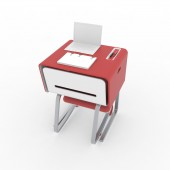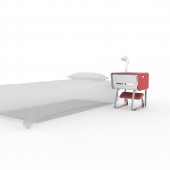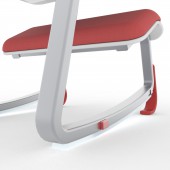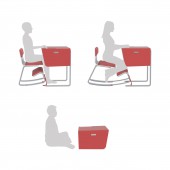Mode Modular Workstation by Gustavo Miranda and Silas Stempcoski |
Home > Winners > #114174 |
 |
|
||||
| DESIGN DETAILS | |||||
| DESIGN NAME: Mode PRIMARY FUNCTION: Modular Workstation INSPIRATION: A design solution that addresses the health consequences due to bad posture and social isolation, potentialized in the Covid-19 pandemic situation, where home office activities have increased fairly. The home comfort is conducive to harmful postures to the spine, due to activities performed in irregular postures, which can, in the long run, mark young people for the rest of their lives. Furthermore, this scenario may lead people to develop mental health issues, increasing discomfort and low life quality. The research base for this project was interviews with users, analysis of work environments, benchmarking, and ergonomic Brazilian standards. UNIQUE PROPERTIES / PROJECT DESCRIPTION: MODE is a modular workstation for home environments that optimizes the home office workplace. In its form and function, it seeks to escape from the classical look and feel of office furniture, conveying a creative and fun side for the home environment, encouraging the users to healthier posture habits. Many home office users feel tempted to work in nontraditional locations. MODE does not dictate what is right or wrong, although it increases the possibilities, optimizes workstations, brings joy and comfort, within a furniture for those who work alone. OPERATION / FLOW / INTERACTION: The product features 3 modules, table, seat, and kneeling module, which can work in different ways. For the compact mode, the furniture work as a side table, adjusting itself to the user’s environment, besides their bed or sofa. Thus, encouraging the use, and promoting a greater feeling of coziness. For using the seat, simply pull the chair from under the table. For using the kneeling module, it is necessary to press the lower button, unlocking the module which can be pulled with the other hand. This movement automatically turns it into a rocking chair, allowing it to tilt back and forth, enabling the user to position themselves in other ways. Finally, the user can remove the tabletop, and use it in other locations. The table’s height makes it difficult to use it lying on a sofa or in bed, therefore building the need for the user to sit in more suitable positions. It also has a negative inclination of 3 degrees, for better visualization of the work appliances. PROJECT DURATION AND LOCATION: The project started in July 2020, and the current version was presented in November 2020. Was completely developed in Curitiba, Brazil. FITS BEST INTO CATEGORY: Furniture Design |
PRODUCTION / REALIZATION TECHNOLOGY: For the structure of all the modules, carbon steel tubes with rectangular sections were used. For the base of the seat, the kneeling module, and the tabletop, molded multi-laminated plywood sheets were used. The upholstered has a plywood base, filled with 33 density foam, which can be covered with different types of fabrics. SPECIFICATIONS / TECHNICAL PROPERTIES: The user’s work surface is 580 mm wide and 600 mm deep, it also applies to the compacted furniture. For the seat, the user enjoys a width of 520 mm for hip accommodation, 100 degrees inclination of the backrest, and 180 mm for the correct lumbar fit, complying with Brazilian standards. For the kneeling position MODE, the device ensures the correct angulation for the user’s legs, with the seat height of 500 mm, and knee inclination according to the standards of the furniture market for this purpose. TAGS: Postural improvement, table, chair, modular, furniture, home office RESEARCH ABSTRACT: The objective of the project was to develop a furniture solution to improve posture and, with that in mind, research started. The first findings showed that the target audience most affected were young people and young adults, who were still developing their posture habits and were, at the time, lockdown in quarantine due to the Covid-19 pandemic. Hence, having to work in a home office, and online learning. After defining the target audience, online surveys were formulated to be applied alongside other materials. Among them, protocols for registering the users' work environments through photos and videos. Subsequently, qualitative, and ergonomic analyzes were implemented, together with a benchmark with existing creative solutions, ensuring a coherent definition of the requirements. The next steps dwell on the ideation phase, generating mood boards, sketches, mockups, and user validation. With the feedbacks, the alternatives were enhanced, resulting in subsequent 3D models. CHALLENGE: The most difficult part was to make the furniture all compacted, at the same time that it needed to present several usability modes. And all of this needed to be in the Brazilian ergonomic standards for office furniture. ADDED DATE: 2020-12-05 01:59:05 TEAM MEMBERS (2) : Gustavo Alves Miranda and Silas Stempcoski IMAGE CREDITS: Gustavo Miranda and Silas Stempcoski, 2020. |
||||
| Visit the following page to learn more: https://bit.ly/3fAE78V | |||||
| AWARD DETAILS | |
 |
Mode Modular Workstation by Gustavo Miranda and Silas Stempcoski is Winner in Furniture Design Category, 2020 - 2021.· Read the interview with designer Gustavo Miranda and Silas Stempcoski for design Mode here.· Press Members: Login or Register to request an exclusive interview with Gustavo Miranda and Silas Stempcoski. · Click here to register inorder to view the profile and other works by Gustavo Miranda and Silas Stempcoski. |
| SOCIAL |
| + Add to Likes / Favorites | Send to My Email | Comment | Testimonials | View Press-Release | Press Kit |
Did you like Gustavo Miranda and Silas Stempcoski's Furniture Design?
You will most likely enjoy other award winning furniture design as well.
Click here to view more Award Winning Furniture Design.








